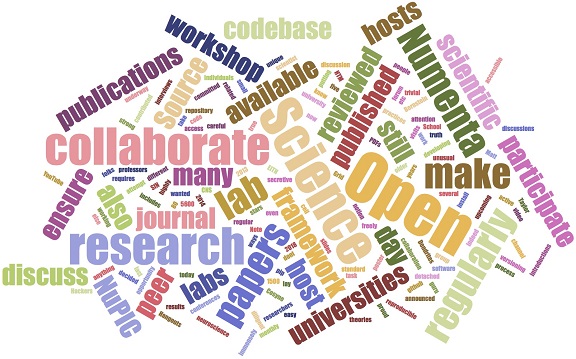As some of you know, we recently posted a major new paper titled “A Framework for Intelligence and Cortical Function Based on Grid Cells in the Neocortex”. We were very fortunate to receive coverage in the New York Times. The article was written about Jeff, our team, and the unusual nature of the research being done at Numenta. Cade Metz, the reporter, did a great job of summarizing, for the layman, the science behind the theoretical framework. The scientific material can be hard to understand, so I appreciated the clear description.
However, the article left some scientists with the impression that we were a closed door research lab, isolated from the rest of the scientific world. While it is true that Numenta is different, the notion that we are secretive and detached could not be further from the truth.
A Commitment to Open Science
I wanted to take this opportunity to lay out the framework for Open Science and collaboration that we have been developing over the last five years. Some of these are standard practices at Universities, but some are highly unusual:
- We have published several peer reviewed journal publications, with more underway. We are committed to open access journal publications, and ensure that all our peer reviewed papers are freely available. We also publish non-peer reviewed papers on arXiv and bioRxiv.
- We regularly participate and present at scientific conferences. In 2018, this includes Cosyne, CNS, the EITN Dendrites Workshop, Grid cell workshop, Bernstein, and the upcoming SfN. For each of these, we make our slides and poster PDFs available.
- We make regular visits to university and research labs. We also regularly host professors and researchers from universities and other labs.
- We decided to open source our software (NuPIC) in 2013. On github, NuPIC today has over 5,600 stars, and more than 80 individuals have contributed to it.
- In 2014 I announced that even our day to day research code would be open. I still don’t know of any other lab that does this!
- We make a diligent attempt to ensure our published results are reproducible. This is not a trivial task, and requires careful attention to versioning. For many of our papers, it’s now as easy as “pip install”. (Note: this is work in process. We are still working on putting some of our older papers in that repository.)
- We host an active discussion group to discuss our codebase, theories, neuroscience, and anything else related. There are over 1,500 people on the forum. Jeff Hawkins, myself, and other Numenta folks regularly participate in the discussions.
- Matt Taylor, our Open Source guru, hosts monthly Hackers Hangouts to discuss our codebase and research. He also hosts a YouTube channel with scientist interviews, HTM School (accessible video introductions to our research), etc.
Numenta is indeed unique in many ways. We are a small lab, but I am immensely proud of our strong commitment to openness and being a part of the broader scientific community. I can’t think of another lab that is as open as we are, and am hopeful that our experiments with Open Science can be a framework and inspiration to others.
Subutai Ahmad, PhD
VP Research
Follow me on Twitter for OpenScience, Neuroscience, and AI related tweets: https://twitter.com/SubutaiAhmad

